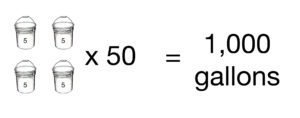1. A plunger is the best solution for a blockage.

Using a plunger to clear all types of blockages is one of many bogus plumbing facts. To begin, consider the source of the blockage. Depending on the size of the item, you may cause more damage or push the item further down the pipe with a plunger. Larger items may need to be removed with a wire and a hook, or best left to plumbing experts.
Secondly, there are 4 types of plungers. Most commonly used in homes are a sink (cup) plunger for sinks, showers and bathtubs and a toilet (flange) plunger. Having both types on hand for minor blockages is recommended. Stop by your local hardware store or order one from an online store before you need it
2. A noisy water heater means it’s going to explode.
The sound you may hear from your hot water heater does not mean it is going to explode, despite what you may have inferred from Saturday morning cartoons! The rumbling noises are usually an indicator of sediment in your tank. Over time, especially if you have hard water, sediment can build up in the bottom of your tank. The noise is a result of the water heater working to raise the water temperature despite the blockage. Not only does the blockage create noise, it affects the efficiency and life span of the appliance. Water heaters can be drained and flushed to remove the build up. That service is recommended yearly.
3. You own your home; therefore, you can repair plumbing issues.
Many homeowners consider themselves DIYers (Do It Yourself), and rightly so. There are many projects that can be successfully completed by homeowners—painting, decorating, and even light carpentry. Other work requires a skilled trades person. Did you know that a master plumber spends a minimum of 6 years training for their job before taking a master plumber exam? Consider that information the next time you plan to fix a major leak after watching a one-minute YouTube video and contact your local plumbing company.
Keep reading to learn about more phony plumbing facts.
4. The toilet water flushes in an opposite direction in Australia because it’s located in the southern hemisphere.
Okay, I’ve been to Australia and the water does indeed flush in the opposite direction. This is not a myth. The direction of the flush, however, is not related to Australia’s place on the map, or The Coriolis Effect. The direction of the flush is dictated by the direction the rim jets (small holes in the toilet bowl) are pointed. Go ahead, find a toilet with rim jets pointed the other way and fool your friends!
5. Low flow fixtures will immediately lower your expenses.
The initial cost savings may be moot, as replacing working fixtures with new versions comes as a sunk cost to you. So, yes, they will save you money and will position your home as eco-friendly but the change does come at an initial cost.

The cost is well-worth it, of course, as the case has been made for replacing older plumbing fixtures, like shower heads and toilets, with new, more environmentally friendly versions. For the most savings, start with installing low flow toilets. The average indoor water consumption in a home from toilet use is 30%, while the average indoor water consumption from shower use is 20%.*
The new fixtures will, indeed, lower the use of water in your home and are better for the earth’s environment overall. In the long run, it’s worth the investment. Do your part and go low flow!
6. A leaky faucet isn’t a big deal.
The last of the bogus plumbing facts in our list actually is a BIG deal!
A leaking faucet slowly drips water and may not accumulate to anything you can measure at first glance. Try placing an 8-ounce water glass under the drip. Take the time it takes to fill the glass, say 30 minutes, and break out your math skills. That’s 384 ounces (3 gallons) in a day or 93 gallons a month, and over 1,000 gallons a year. Now, that sounds like a bigger deal than you may have thought!
Contact your local plumber to repair leaks in your home today.
* http://www.thegreenspotlight.com/2010/08/high-efficiency-water-saving-plumbing-fixtures/


